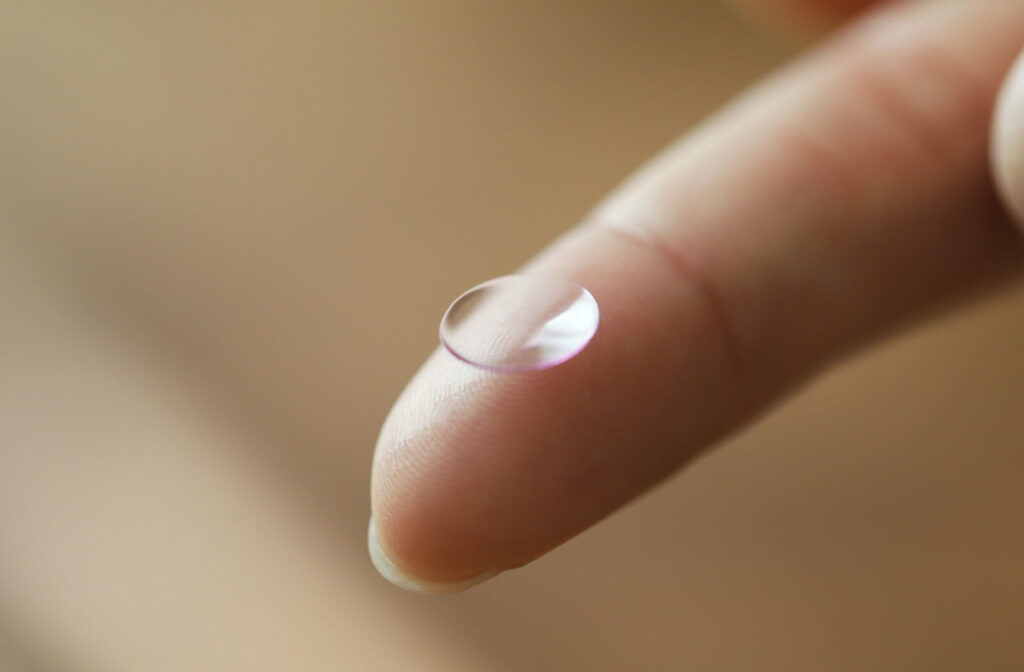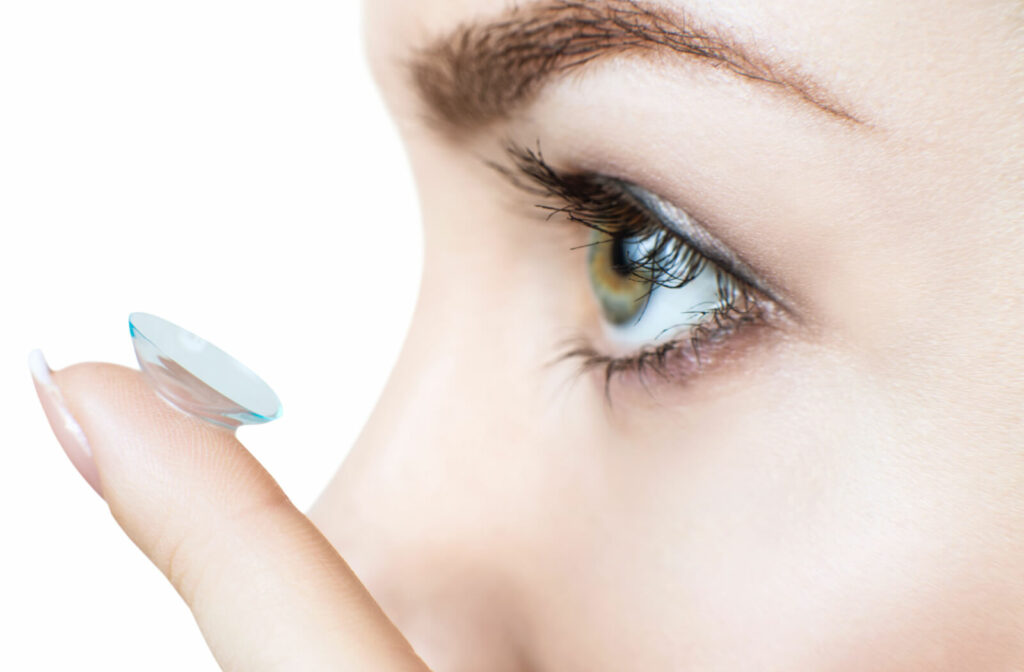When you’re experiencing dry eye symptoms, wearing contact lenses can feel like sandpaper in your eyes: gritty, uncomfortable, and irritating. But dry eyes don’t mean you have to abandon contact lenses completely—through a contact lens exam and fitting, your optometrist can assess your eyes and help you find the right lenses for your needs.
Depending on your needs and the cause of your dry eyes, you may find success with a variety of lenses. Soft contact lenses, daily disposables, and scleral lenses can all be suitable options for people with dry eyes.
When selecting your contact lenses, your optometrist will consider the lens material, water content, replacement schedule, or specialty lenses to alleviate dry eye symptoms. Contact lenses won’t worsen dry eye symptoms as long as they’re the right lenses for you.
What Is Dry Eye?
Your eye’s comfort relies on having a well-balanced, healthy tear film. However, if your eyes aren’t producing enough tears or are producing low-quality tears, it can indicate a problem with your tear film, resulting in dry eye symptoms.
The 3 elements that make up your tears include:
- Oil, the top layer that delays tear evaporation
- Water, the middle layer that moisturizes the eye
- Mucus, the inner layer that helps the tears stick to the eye’s surface
In healthy eyes, the tear mixture from the glands above your eye spreads over the eye’s surface with every blink, draining into the tear ducts. Dysfunction with the tear-producing lacrimal or meibomian glands or drainage can lead to dry eye.
Causes of dry eye can include:
- Natural aging
- Hormonal changes
- Damage to the tear glands
- Specific medication
- Environmental conditions
Symptoms of Dry Eye
A range of symptoms are associated with dry eye disease, including:
- Blurry vision
- Burning, gritty, or stinging sensations
- Excessive eye watering
- Feeling that there’s something in your eye
- Tired eyes
- Sensitivity to light
If you’re experiencing these symptoms while wearing your contact lenses, your optometrist can help you find more comfortable alternatives for your eyes.

What to Look for in Contact Lenses for Dry Eye
An estimated 45 million people choose to wear contact lenses to correct vision problems. However, a projected 50% of those who wear contact lenses deal with related dry eye symptoms.
Your optometrist may recommend trying contact lenses with specific features to improve your comfort and relieve dry eye symptoms. Lens material, water content, replacement schedule, and contact solution can influence how your eyes feel while wearing your contact lenses.
Lens Material
Soft contact lenses are the most common material and are preferred for their easy adaptability. The flexible plastic allows oxygen to pass through the lens to the cornea, moisturizing the eye’s surface.
Rigid gas permeable (RGP) contact lenses are hard lenses less prone to the buildup of eye-produced deposits. Oxygen can still easily pass through the lens to keep your eyes healthy, but they take longer for your eyes to get used to. If you have astigmatism, RGP lenses can offer a significant boost of crisp, clear vision since the lens maintains its shape.
Water Content
A higher water content doesn’t equal more moisture in contact lenses. Most soft contact lenses are made of hydrogels containing water. When inserted, they feel hydrating, but the water may evaporate quickly, drying them out faster. Once your contact lenses begin relying on your tear film for lubrication, it can worsen dry eye symptoms.
Wearing silicone hydrogel contact lenses instead may provide 5 to 10 times more oxygen than lenses made of other materials. Silicone hydrogel lenses may also prevent tears from evaporating as quickly as water-based hydrogels, significantly decreasing dry eye symptoms.
Replacement Schedules
Buildup and deposit accumulation on your contact lenses can increase the gritty feeling that something is in your eye, whether it’s from makeup, dust, or debris. Those with dry eyes may prefer daily disposable contact lenses instead.
Through their single-use design, daily disposables overcome this problem. You don’t have to store or worry about sanitizing them. You simply throw them away at the end of the day. This replacement schedule can also help prevent eye infections related to contact lens wear.
Scleral Contact Lenses
Scleral lenses are a type of RGP lens and are wider than standard contact lenses, measuring from 14 to 24 millimeters in diameter. Rather than resting directly on the cornea, they rest on the sclera, the white of the eye, and arch over the cornea leaving space for a fluid reservoir. The moisture helps keep the surface of the eye comfortable for longer, which may reduce irritating dry eye symptoms.
Contact Solutions
Not all contact solutions are the same, so before you grab any brand off the shelf, discuss the options with your optometrist. They may recommend specific solutions most compatible with your type of contact lenses.
Get a Contact Lens Fitting & Exam
Contact lenses are personal, and what works for your eyes will be unique. Schedule a contact lens fitting and exam with the Charles Korth Optometry team to find the most comfortable pair for your dry eyes and vision correction needs.




